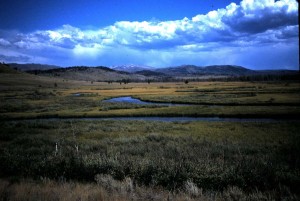Duck Creek in Yellowstone Park
There are duck creeks all over the Rocky Mountain west just as there are elk creeks, moose creeks, and spring creeks. But Duck Creek in Yellowstone Park is special amongst the duck creeks. Situated between the intensely media targeted Madison and Gallatin rivers, it is overlooked by so many fly-fishers. But for those seeking very large trout and owning a high skill level for successful large trout encounters, Duck Creek is the equal of these two famed rivers. Where one first sees it crossing US Highway 191 about eight miles north of West Yellowstone and just south of the Quake Lake junction, Duck Creek looks hardly worth any attention. Here it looks like a stream of gradient such as the South Fork of the Madison River crossing US highway 20 west of West Yellowstone, but in more degraded environs. But if one takes the turn-off to the right at the Montana State Highway Maintenance Station just to the south of this crossing from Highway 191, one can be in for a great discovery. On the turn-off, drive past the subdivision and on to the Park boundary indicated by a series of posts. The road bares to the left along the posts and ends at a turn-around. Flowing past the turn-around on the north, Duck Creek exits the Park to enter a private pond bordering the subdivision. On the east side of the turn-around one can see a trail going east through the sage brush. This trail is the remains of an old access road now blocked from motorized travel. To one’s left Duck Creek is partially visible, and its change of character begins to hint at what is ahead. At the end of the trail, a few hundred yards from the turn-around, a scene of meadow creek splendor confronts the visitor. See the evening scene in the picture above. “Why, thinks the first time visitor, have I not visited this place before?” “Ah, it is so great to be back, thinks the fly-fisher of much Duck Creek experience.”
So how does one fish this classic meadow stream? Let’s begin with this time of year and discuss other times of the year in future articles. Have you heard the term ” Henry’s Fork Hunchback” born on the Henry’s Fork in Harriman State Park? The “Duck Creek Crawl” is more appropriate here, for any adult of close to average height or more will be the tallest object in the more than mile-long meadow in view. Within that meadow the creek winds about three miles and has a deep hole with undercuts at every bend. The trick is to bring that big brookie, brown, or ‘bow that can range up to several pounds out of that bend to take your false offering. It means stealth to the greatest degree with all effort to keep out of view. The further one progresses up the meadow, the smaller the stream becomes, but trout up to very large sizes remain. Throughout, it means drifting your offering downstream on a long, fine leader, drag-free at the same time as the meager current while keeping out of sight as much as practical. For the dry fly enthusiast, PMD, terrestrial, and damselfly patterns are the best choices. Do you have a small grass snake pattern? Don’t laugh; you will surely encounter few trout by presenting such, but one you do could bethe fish of the year. The same applies with a hair mouse. For presenting both, the axiom “fish early, fish late” applies and it turns out this is the best way to fish Duck Creek with any fly pattern this time of year. There is a bonus for fishing here if you do not mind walking up the meadow about a mile. That is a series of beaver ponds where the creek turns to the south side of the meadow. Bring your favorite leech pattern to try in these. Above, where Richards and Gneiss Creeks come together forming Duck Creek, further access is not possible as these streams border the west side of a bear habitat closure. So yes, it may be wise to carry bear spray and occasionally give a blast from a claxon horn. True, the presence of bears help keep down the number of fly-fisher visits to the upper meadow, but in my hundred or so of such visits, I have seen only one grizzly. He was as impressive as any in this region, but caused no harm. Here are a few other thoughts. Wading wet is very appropriate as there are several creek crossings where water is not even knee deep. It is, however, best to stay out of the creek as much as possible because stirred up sand and silt will alert downstream trout that something is amiss and it is time to hide in that undercut. Bring potable water. And don’t forget “fish early, fish late!”

